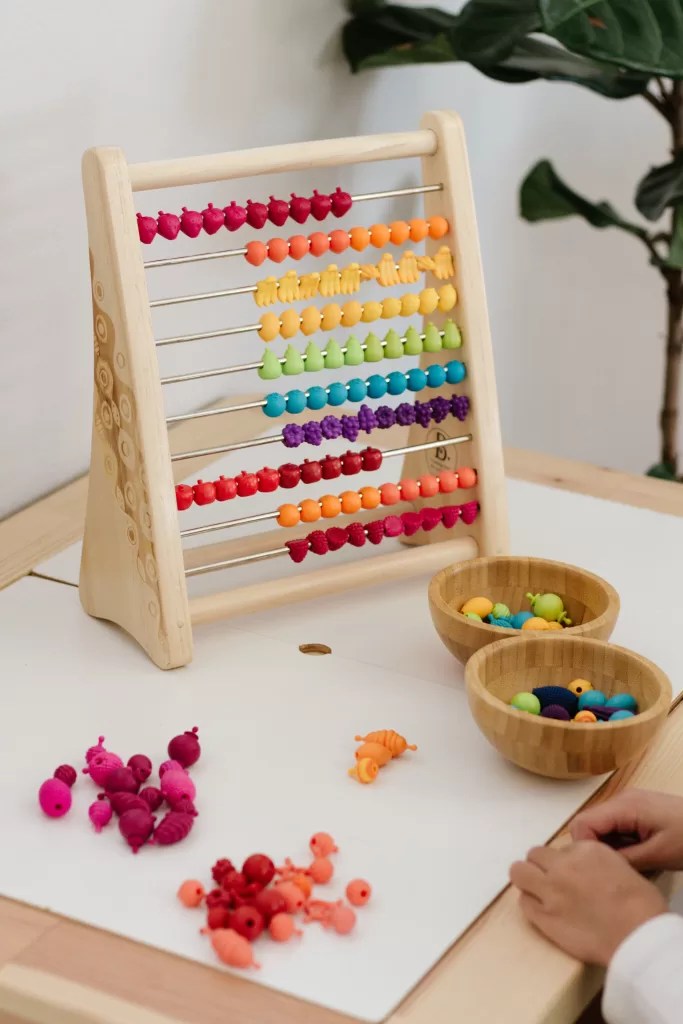
Basics of Learning through Play
One of the questions I get the most is how to teach children through play. I think we often tend to over complicate things as adults. It’s actually fairly simple. Children are already naturally curious and love to learn. It’s when learning becomes a chore that they no longer have interest in learning. Here are a few basic guidelines when teaching any concept through play.
1: Keep it Simple
You really don’t need a lot of things to start learning. If you’ve been following me on my @purposefultoys account on instagram you know that I definitely love a good resource, but it’s not a need. You can create simple games with things laying around your house. For example a great way of teaching letters is by writing the upper case letters on 26 plastic spoons and using another 26 spoons to write the lower case letters. The child then can match the upper and lower case letters together by placing the spoons on top of one another. Another example with letters is simply gathering random objects around the house and placing them in a bag. Have the child randomly select an item and tell you what letter or sound that object starts with. If you have some sort of letters laying around the house they could match them with the object (as pictured below). Get creative, everyone can teach with whatever they have on hand. When we tend to add too many elements it gets over complicated for our children, so keep it simple.

2: The Key is Your Language
When teaching any concept, the key is your language. It’s not necessarily the activity, although that can aide as a tool, but it’s the way you speak that truly makes the difference in learning and development. When teaching young children it’s important to compliment them on specific components of what they are working on. For example if a child shows you their drawing instead of saying something like, “Wow good job!” Try something like, “Wow, you worked really hard on that!” or “I like how you used a lot of colors.” or “My favorite part was watching you draw the circle, what was your favorite part?” Language such as this helps them to increase in confidence as they feel validated specifically in their efforts and that you really paid attention to the details of their drawing. Too often when we simply say something like, “Good job!” the child feels a little dismissed like you didn’t actually take the time to appreciate their creation.
Another component of language is how you help to scaffold them through their process of learning through play. For example, If we are engaged in a sensory activity about planets and my daughter begins collecting all of the planet toys I might say something like, “What planet is the biggest?” If they aren’t sure maybe we can first guesstimate by looking at their sizes and then include research skill by looking it up in a book or online. This simple guided question can lead to other concepts such as order sequencing, “Can you put them in order from largest to smallest?” We might ask questions such as, “How many planets do you have?” if the child doesn’t know then you could say, “Let’s count together.” Conversations like these not only open up doors for more learning, but they help the child to continue being engaged in play.

3: Have Open Ended Activities/Resources
What do I mean by “open-ended”? Well, open ended simply means that there are endless ways to play. When we create an activity with a specific end goal in mind we tend to forget where the bulk of learning actually takes place, during the process. Provided resources that can be manipulated and changed to fit an endless amount of ideas allows your child to get creative and begin learning with little direction. For example, in the picture above I simply put out these beads, a few bowls, and a counter. In my mind she was going to use the counter to find the associated color and count to 10 with each color. But I didn’t give any direction on this one. As she sat down and began playing, she started to move the counter to the amount she determined and then started sorting the beads into color groups. Once the groups were formed she then began counting out the beads to match the amount she had determined on the counter. In the end my objectives were met, and she felt like it was play more than a chore because I didn’t tell her how to play or what to do with the resources I provided.

4: Process vs. Product Oriented Play
This is honestly my main take away from my courses studying child development. Often times when we view success we only view the success, forgetting the large chunk of process that needed to take place in order to get there. This goes right along with what I was saying in the section above. If we are too focused on the end goal of say an art activity, then we forget where learning actually takes place, such as the fine motor skills of the cutting, the pencil holding skills gained by manipulating drawing utensils, the creativity in determining what their creation should look like rather than being told what it should look like. The process is where the magic happens!

5: Child Led Play
One of the best ways learning takes place is when the child is taking the lead, not the adult. We as adults can encourage learning by setting out open ended resources for our children, but it’s important to allow our children to take the lead. If they want to move on to another activity great. Forcing a child to engage in a particular activity tends to lead to lack of interest and engagement. It’s our job to simply be available to enhance learning opportunities by answering their questions, and giving guided statements or questions to foster the learning during their particular activity of choice. We can also do this by trying to accommodate their ideas. If your child is playing with play dough and says, “Mom I need a rolling pin” do your best to accommodate their requests. They have something creative and magical in mind and need us to allow for them to take the lead.
When you have these basic concepts in mind you are better able to teach learning through play despite the various concepts you might be trying to teach! Stay tuned for a blog post all about teaching letters and sounds full of resources and ideas!
